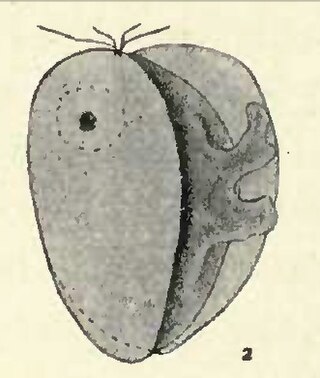
The Archaeplastida are a major group of eukaryotes, comprising the photoautotrophic red algae (Rhodophyta), green algae, land plants, and the minor group glaucophytes. It also includes the non-photosynthetic lineage Rhodelphidia, a predatorial (eukaryotrophic) flagellate that is sister to the Rhodophyta, and probably the microscopic picozoans. The Archaeplastida have chloroplasts that are surrounded by two membranes, suggesting that they were acquired directly through a single endosymbiosis event by phagocytosis of a cyanobacterium. All other groups which have chloroplasts, besides the amoeboid genus Paulinella, have chloroplasts surrounded by three or four membranes, suggesting they were acquired secondarily from red or green algae. Unlike red and green algae, glaucophytes have never been involved in secondary endosymbiosis events.

Telonemia is a phylum of microscopic eukaryotes commonly known as telonemids. They are unicellular free-living flagellates with a unique combination of cell structures, including a highly complex cytoskeleton unseen in other eukaryotes.

Malawimonadidae is a family of unicellular eukaryotes of outsize importance in understanding eukaryote phylogeny.

The cryptomonads-haptophytes assemblage is a proposed but disputed monophyletic grouping of unicellular eukaryotes that are not included in the SAR supergroup. Several alternative names have been used for the group, including Hacrobia ; CCTH ; and "Eukaryomonadae".

Ancyromonadida or Planomonadida is a small group of biflagellated protists found in the soil and in aquatic habitats, where they feed on bacteria. Includes freshwater or marine organisms, benthic, dorsoventrally compressed and with two unequal flagellae, each emerging from a separate pocket. The apical anterior flagellum can be very thin or end in the cell membrane, while the posterior flagellum is long and is inserted ventrally or laterally. The cell membrane is supported by a thin single-layered theca and the mitochondrial crests are discoidal/flat.

Diaphoretickes is a major group of eukaryotic organisms, with over 400,000 species. The majority of the earth's biomass that carries out photosynthesis belongs to Diaphoretickes.

Raphidiophryidae is a family of mostly freshwater centrohelids. It is the sister family of Acanthocystidae, sharing the trait of presenting silica scales and comprising the clade Chalarothoracina. Two genera, Raphidiophrys and Polyplacocystis, have been discovered so far.

Collodictyonidae is a group of aquatic, unicellular eukaryotic organisms with two to four terminal flagella. They feed by phagocytosis, ingesting other unicellular organisms like algae and bacteria. The most remarkable fact of this clade is its uncertain position in the tree of life.
Rigifilida is a clade of non-ciliate phagotrophic eukaryotes. It consists of two genera: Micronuclearia and Rigifila.

Varisulca was a proposed basal Podiate taxon. It encompassed several lineages of heterotrophic protists, most notably the ancyromonads (planomonads), collodictyonids (diphylleids), rigifilids and mantamonadids. Recent evidence suggests that the latter three are closely related to each other, forming a clade called CRuMs, but that this is unlikely to be specifically related to ancyromonads

Cryptista is a clade of alga-like eukaryotes. It is most likely related to Archaeplastida which includes plants and many algae, within the larger group Diaphoretickes.

Haptista is a proposed group of protists made up of centrohelids and haptophytes. Phylogenomic studies indicate that Haptista, together with Ancoracysta twista, forms a sister clade to the SAR+Telonemia supergroup, but it may also be sister to the Cryptista (+Archaeplastida). It is thus one of the earliest diverging Diaphoretickes.
Endohelea is a proposed clade of eukaryotes that are related to Archaeplastida and the SAR supergroup. They used to be considered heliozoans, but phylogenetically they belong to a group of microorganisms known as Cryptista.
Palpitea is a proposed clade of eukaryotes that are related to Archaeplastida and the SAR supergroup.
Corbihelia is a proposed phylum of eukaryotes.
Mantamonads are a group of free-living heterotrophic flagellates that move primarily by gliding on surfaces. They are classified as one genus Mantamonas in the monotypic family Mantamonadidae, order Mantamonadida and class Glissodiscea. Previously, they were classified in Apusozoa as sister of the Apusmonadida on the basis of rRNA analyses. However, mantamonads are currently placed in CRuMs on the basis of phylogenomic analyses that identify their closest relatives as the Diphylleida and Rigifilida.

CRuMs or Crumalia is a proposed clade of microbial eukaryotes, whose name is an acronym of the following constituent groups: i) collodictyonids also known as diphylleids, ii) rigifilids and iii) mantamonadids as sister of the Amorphea. It more or less supersedes Varisulca, as Ancyromonadida are inferred not to be specifically related to the orders Diphylleida/Collodictyonida, Rigifilida and Mantamonadida.
Mantamonas sphyraenae is a species of marine heterotrophic flagellates described in 2021. It belongs to the Mantamonadida, a basal eukaryotic lineage within a clade known as CRuMs. Its diploid genome is the first to be assembled within the CRuMs group.
Mantamonas vickermani is a species of marine heterotrophic flagellates described in 2021. It belongs to the Mantamonadida, a basal eukaryotic lineage within a clade known as CRuMs.
Mantamonas plastica is a species of marine heterotrophic biflagellates described in 2011. It is the type species of the Mantamonadida, a basal eukaryotic lineage within a clade known as CRuMs.










